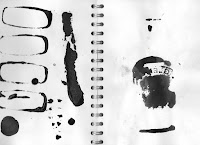What went well?
- I think that using a dramatic composition here is really effective in making a very simple concept visually exciting. I am definitely going to conceder composition more in my future images.
- I also think that this works well as a square image. The harsh cropping of the legs adds to the drama of the composition and draws your eye in.
What challenges did I face and how am I going to move forward?
- Initially, having done a couple compositional drafts I was going to take forward an image not because it was the most interesting composition but because it was the easiest to draw in perspective. I think that this is something that I often do and that I perhaps need to start taking more risks. It definitely pays off and it's even worth having things slightly out of proportion if it leads to a more dynamic composition.
- I had lots of trouble with the angle of the leg. If I had more time, I could have got someone to take a picture of my leg from underneath, to use as a reference.













































